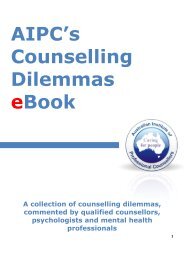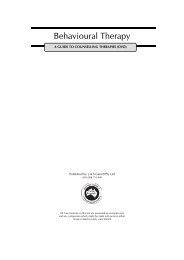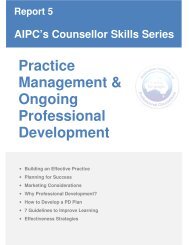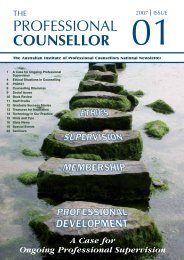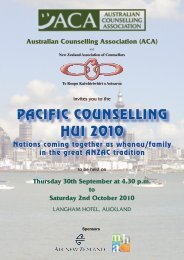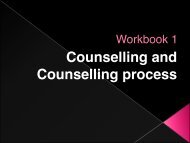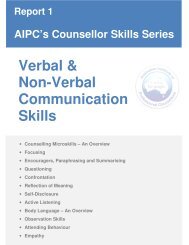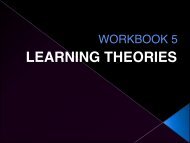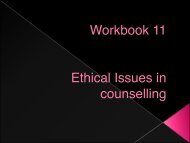Why Diversity? - Counselling Connection
Why Diversity? - Counselling Connection
Why Diversity? - Counselling Connection
- No tags were found...
Create successful ePaper yourself
Turn your PDF publications into a flip-book with our unique Google optimized e-Paper software.
AIPC’s Counsellor Skills Series, Report 3WORKING WITH CHILDREN AT RISKAs stated in The Australian Institute of Family Studies, 2004 edition of Identifying andResponding to Child Abuse and Neglect, the sad facts are:There are four recognised types of child abuse: physical abuse, sexual abuse,emotional/psychological abuse, and neglect. Children and young people are mostoften abused by a parent or a carer. The rates of substantiated abuse or neglectdecreases as age increases, children under the age of one year old are the mostlikely to be subjected to a substantiated report of abuse, and children 15-16 years ofage are the least likely.There is no accurate statistical information on the prevalence of child abuse in Australia. Themost accurate statistical information available is based on the number of reports ofsuspected child abuse made to the statutory child protection departments in each state.While these statistics give some indication of the extent of this problem in our society, it iswell known that a large number of cases of child abuse go unreported.Difficulties arise in obtaining accurate statistics regarding child protection because inAustralia state governments have the statutory responsibility for protecting children fromabuse and neglect, however the definitions of what constitutes child abuse differs across thestates and territories, and mandatory reporting requirements also differ between the statesand territories. Thus it is difficult to obtain consistently comparable statistics to give anational indication.However of the number of substantiated cases reported, 28% comprise of physical abuse,10% sexual abuse, 34% emotional abuse and 28 % neglect.Overly represented in child abuse substantiated cases are families with a complex range ofsocio-economic problems such as poor housing, poverty, unemployment, substance abuse,single parent families, social isolation, and family and domestic violence. Parents faced withthese challenges often require additional support to care for their children, as abuse of achild seldom happens once; it is often a process that can persist over many years.Aboriginal and Torres Strait Islander children and young people are eight times more likely tobe reported in child protection statistics than non Aboriginal and Torres Straight Islanderchildren. While children with disabilities especially those with chronic health problems orserious disabilities are more vulnerable to abuse or neglect as a result of stress that “aroundthe clock” care can create for carers.Adults who were abused as children are at greater risk of developing psychological andemotional problems later in life and of repeating the pattern of abuse with their own children.Learn How You Can Gain Specialty ExpertiseAnd A Graduate Qualification With A VocationalGraduate Certificate Or Vocational GraduateDiploma In <strong>Counselling</strong>…… In Only 6 to 12 Months!www.aipc.net.au/vgdPage 22



